|
|
|
Early Autumn Greetings to all readers,
If only it would start to cool down...
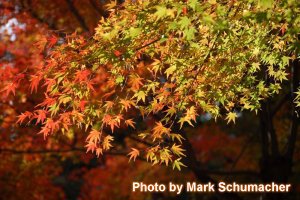 |
|
While it is already early September, no one seems to have told the climate! Summer heat rages here in Japan, and the punishing humidity along with it. But having entered this - my favorite month of the year - a gaggle of industry tastings is just around the corner. Tiring though it might be, it will be fun.
And of course there is the cuisine of fall, easily as good as it gets in Japan for me, vibrant in appearance and well-developed in flavor and taste. And of course, there is sake: last season's brews are still just a bit young, and boast that very appeal. Maturity can be enjoyed again later.
Other upcoming news:
I will hold the autumnal Sake Professional Course October 28 to 30 in Las Vegas, Nevada. Hang around after the course for Halloween in Vegas - that has to be fun. You can learn more below, or by sending me an email to that purport.
And please, as always, enjoy the newsletter - preferably with a glass of autumnal sake!
Warm regards,
John Gauntner
|
|
Non-foaming Yeasts
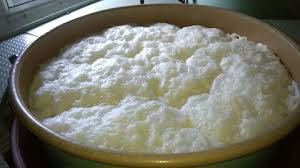 |
|
Admittedly, the subject of yeast types begins to push the envelope of geekdom. While some want to know both in theory and practice the difference between a Number 9 and a Number 10, and perhaps even between a CEL-24 and EK-1, most of us are content to sip and smile. Even so, there are some interesting historical, cultural and technical anecdotes surrounding even things as dryly scientific as yeast, and the topic of foamless yeasts, or "awanashi kobo," is one such example.
First of all, just what is foamless yeast? Usually, when sake undergoes its 20- to 40-day fermentation, the foam rises in great swaths and falls again, especially over the first third or so of this period. In fact, brewers of olde would judge the stage, progress and condition of a given batch by the appearance (and smell, and taste, and even sound) of this foam atop the fermenting mash. Also, there are ten times more yeast cells in the foam than the mash itself, so very often yeast for subsequent batches is removed from the foam of healthy, vibrantly fermenting tanks.
So foamless yeasts, obviously, are strains of yeast that do create as much foam (there still is a little bit) as they convert sugars to alcohol, carbon dioxide, and more. The question is, why would anyone want to use them?
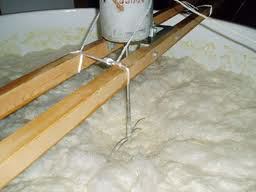 |
|
There are, actually, a number of very good reasons. Most of these are centered around efficiency, sanitation, labor-savings, and even safety. For instance, since the foam rises so high during fermentation, brewers cannot fill a tank to the brim with rice, koji and water since it would soon overflow with foam, leading to hygienic nightmare. Rather, they can only fill the tank initially about 3/4 of the way to leave room for the foam to rise and fall. Naturally, this puts a damper on one's yields and efficiency. There may be 30 tanks in a fermentation room, but if you can only fill each up 3/4 of the way, your monthly yields are only 75 percent of what they might be. With foamless yeasts, however, this concern is all but a non-issue, and a brewery can get the higher yields out of each batch and tank.
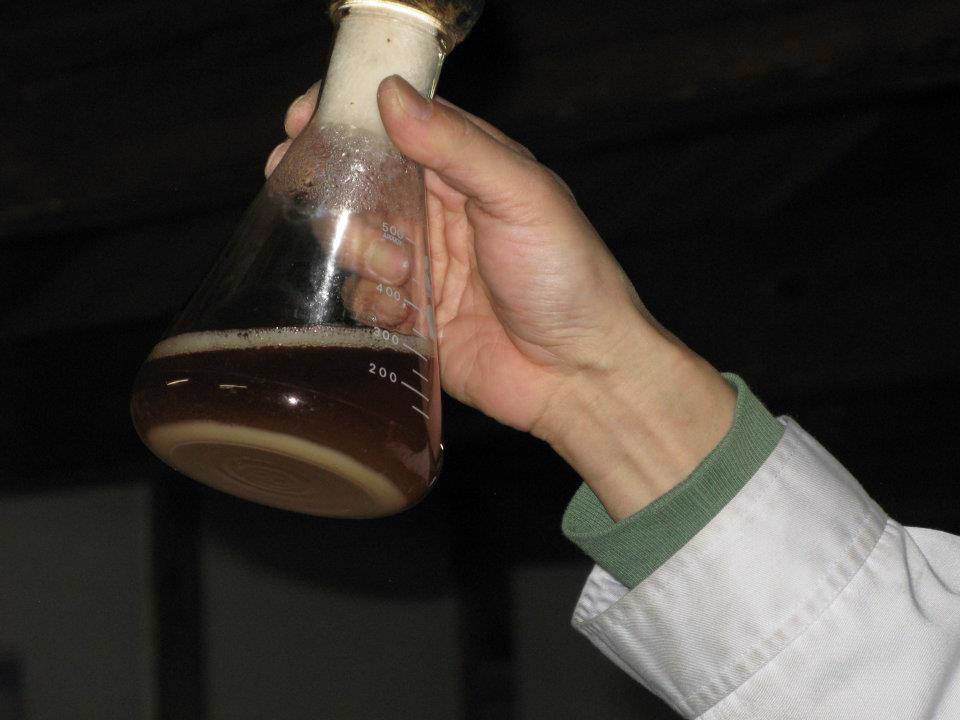 |
|
Also, when foam does rise and fall, the remains that cling to the side of the tank are a veritable hotbed of bacterial activity, an orgy of undesirable microorganisms just hankerin' to drop back in and do damage to the unsuspecting ambrosia-in-waiting below. So this must be assiduously cleaned off by the brewers. Not only is this hard and time consuming work, it is also quite dangerous, since it generally requires leaning into the tank. Falls into tanks are almost always fatal since there is no oxygen and the huge amount of carbon dioxide billowing up from the mash is harshly engulfing. So by eliminating the foamy remains, time, labor, and risk are spared. Finally, without all that gunk in the way, the hard-working yeast cells move and work a bit more freely, so that fermentation proceeds a smidgeon faster and can finish a day or two earlier.
Why are they foamless? What happens, it seems, is that most yeast cells will cling to bubbles of carbon dioxide that are created and then rise to the surface. Foamless yeast cells, on the other hand, for whatever reason do not cling to these bubbles and so are not carried up, up, and away. Since the bubbles are unencumbered, they pop, and there is no foam rising high above the mash.
The foamless yeasts that are commonly encountered out there today are non-foaming versions of the "usual suspects," rather than being new, unknown, or total mutant life-forms.
Actually, they appear naturally and spontaneously. About one in every several hundred million yeast cells of a given type are foamless, but obviously, if just one in several hundred million is non-foaming, no one will notice. It just takes patience to isolate some and cultivate a pure culture of them.
Also, they have been around a long time, it seems, but proper records go back until only about 1916, when several breweries reported experiences with them. Apparently, until then, the brewers that encountered these thought, "Whoa. This can’t be right. Let's just quietly throw this mutant away before anyone finds out about it. It could be bad for our rep and all."
 |
|
While foamless yeasts were used sparingly and experimentally for decades, the first commercial use of a foamless yeast was actually in Hawaii, believe it or not. In 1960 or 1961, a full ten years before it was used on anything remotely resembling a large scale in Japan, foamless yeasts were used by Takao Nihei of the Honolulu Sake Brewery. Dispatched by the brewing research organization within the government of Japan, he was the first to take what information there was on these yeasts (and a sample, of course) and run with it. His focus was saving labor and producing great sake with great efficiency, and this he did with great success.
Are these foamless yeasts
really the same as their bubbling counterparts, except for the foam? Most brewers say, "Yes, the results are essentially same, and the practical advantages make it a clear choice for us." However, there are a still a few hardcore toji who insist that the foamless manifestations are
not quite as good as the foaming yeasts. Naturally, the ability to gather information from the appearance of the foam is eliminated. Still, most brewers feel that with foamless yeasts they get the same quality of sake, with less mess.
Foamless yeasts, at least those distributed by the Brewing Society of Japan, are designated by a -01 after the normal nomenclature. So a foamless Number 7 is known as 701, foamless Number 9 as 901, and so on. Those you are most likely to come across these days are 701, 901, and 1801.
Brewers are not obligated to provide information on the choice of yeast used, but often do. While there are countless yeasts used in sake today, just a few are non-foaming, and now you can recognize them.
|
Sake Brewery Tours in Japan, 2014
Here is the latest from Sake Tours :
We are very excited to announce two new destinations in 2014 to Okayama (January 27th - 31st) and Niigata (February 17th – 21st). There’s something special about these two destinations. The Japan Sake and Shochu Makers Association is supporting part of the cost. They invite all sake enthusiasts to really experience Japan through sake with their help. This is a one-time opportunity you cannot miss!
Both tours are 5-day excursions into the world of sake brewing, drinking, and enjoyment, featuring an exclusive seminar by the greatest sake sensei. The contents of the tours feature sumptuous cuisine, luxurious yet quiet relaxing time at hot springs, and excursions to fantastic cultural highlights in areas seldom visited by foreigners.
Okayama January 27 - 31, 2014 (Monday-Friday)
Visit four sake brewers in the home of Omachi sake rice. The Okayama tour combines sake, food, and art with visits to beautiful classic towns. Some very memorable experiences you will find only with us are: a session with Omachi sake rice grower, hands on rice field plowing, private Kagura dance performance, private Shiki Hocho fish cutting knife ritual once performed only for the emperor, hands-on guinomi sake cup making experience with Bizen artists, observing art of sword making and more. On the last day, simply relax at the hot springs by the river far away from the city, in the snow.
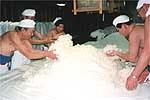 |
|
Niigata, February 17 – 21, 2014 (Monday-Friday)
Niigata is known as the sake and rice capital. From over 90 breweries, you will visit four breweries who represent very distinctive traditions including Sado Island. In addition to a chance to interview sake brewers and rice growers, some special moments include: a private Geisha performance at dinner, a masterful tea ceremony, paring of Niigata sake at French restaurant, and hands on experience of Kodo Taiko drum. Of course, we'll have time to explore the distinctive cultural heritage of the area and to relax at hot springs.
Both tours are 270,000 JPY per person. With 50,000 JPY support from Japan Sake and Shochu Makers Association, your cost is only 220,000 JPY.
Please visit http://saketours.com for tour information after September 15. Group size is limited to 12.
Details are still being finalized for the Okayama and Niigata tours, so email Etsuko at info@saketours.com for more information. 2014ke is.
|
 Announcements and Events Announcements and Events
Sake Professional Course
Las Vegas, Nevada, October 28 to 30, 2013
Now accepting reservations...
The next Sake Professional Course will take place October 28 to 30, at the MGM Grand Hotel in Las Vegas, Nevada.
More about the seminar, its content and day-to-day schedule, can be found here .
The Sake Professional Course, with Sake Education Council-recognized Certified Sake Professional certification testing, is by far the most intensive, immersing, comprehensive sake educational program in existence. The three-day seminar leaves "no sake stone unturned."
The tuition for the course is $825. Feel free to contact me directly at sakeguy@gol.com with any questions about the course, or to make a reservation.
~~~~~~~~~~~~~~~~~~~~
Sake Education Council Website
Please take a moment to check out the website for the Sake Education Council, the organization behind the Certified Sake Professional and Advanced Sake Professional certifications. We plan to grow steadily, strongly and continually, and we will need the support of all those that love sake to do so. Follow us through the "usual suspects" of social media.
Sake Homebrewer's Online Store
Please be sure to check out Homebrewsake.com for supplies, information and a forum, including lots of supporting information on everything from recipes to history. I have been meaning to mention this site and the gentleman behind it, Will Auld, but have repeatedly forgotten in past newsletters. The site is replete with instruction, augmented with videos, schedules, and more. If you are even remotely interested check this site out right away.
Don't forget the archives!
Older editions of this newsletter are archived here.
Really old editions are archived here.
|
 Sake Education Central Sake Education Central
Sake's Hidden Stories and The Sake Notebook are now available for the Kindle, Nook and iBooks!
The Sake Notebook is now available for the Kindle as well as the Nook. And now, it is available for iBooks on iTunes as well!
Sake's Hidden Stories too is now availabe on the Kindle as well as the Nook. And now, it is available for iBooks on iTunes as well!
Both are
less expensive than their original pdf version too. Now is your chance to learn more about sake from your phone or tablet! Check 'em out!
Sake Dictionary App for the iPhone, iPod and iPad
"For 99 cents, this app ROCKS!!"
-a satisfied customer
There you are, perusing a menu, or standing in front of a shelf of great sake, or perhaps reading a sake newsletter… and up pops one of those hairy, pesky sake terms in Japanese. You know you have heard it many times, but dammit, you just cannot remember what it means now…
No problem! Just whip out your iPhone or iPod and fire up your trusty old version of
The Sake Dictionary. In a matter of seconds, you’ll be amongst the cognoscenti once again. But… if only you could pronounce it properly. Now that would really rock!
Done! Just tap on the term and you will hear a clear example of how to pronounce the term in Japanese. Repeat it a couple of times and the term is yours for eternity, to toss about and impress your mates.
What’s more, it’s
less!
Less than what it cost before, much less. Like less than one-seventh less. For a limited time only, the audio-enhanced version of The Sake Dictionary iPhone app is available for a mere $0.99.
|
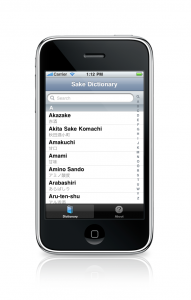 |
|
|
The Sake Dictionary is a concise little package of all the terms you might ever come across when dealing with sake. Almost 200 of them - including sake grades, rice variety names, seasonal sake terms, special varieties, rare types, post-brewing processing words and the myriad terms used in sake production - many of which are not even familiar to the average Japanese person on the street - are listed up here with concise, useful and clear definitions and the written Japanese version as well. And now, with the new audio component, you can listen and learn just how to pronounce those terms properly.
Start to toss around Japanese sake terms like you were raised knowing them! Gain a level of familiarity hitherto unimaginable! Avoid frustrating paralysis when faced with a sake-related purchase!
Get your copy of The Sake Dictionary now and never be confused by sake terms - or how to pronounce them - again.
Get it here: http://itunes.com/apps/sakedictionary
(Note if you have already purchased it, this upgrade to the audio version is free. Just go to iTunes and get it!)
|
Are you not getting this newsletter? I realize that is like asking that
"those not present please raise your hand," but for future reference, should you spontaneously stop receiving this newsletter, please go here and sign up again. Should that not work, please go to www.sake-world.com.
Email newsletter services are very careful not to be considered spam enablers, but the problem is that often very valid email addresses come back bounced as invalid. It is an unavoidable problem. So if you or someone you know is not getting this, or stop(s) receiving it inexplicably, please do take a moment to double check that you are still subscribed.
Sincere apologies for the hassle, mixed with gratitude for reading this newsletter. |
I hope you have found the above information helpful and entertaining. For more information about all things sake, please check out www.sake-world.com. Until next month, warm regards, and enjoy your sake. 
Questions and comments should be directed to John Gauntner, at this email address.
All material Copyright, John Gauntner & Sake World Inc.
Regards,
John Gauntner
Sake World, Inc
 . . 
|
|
